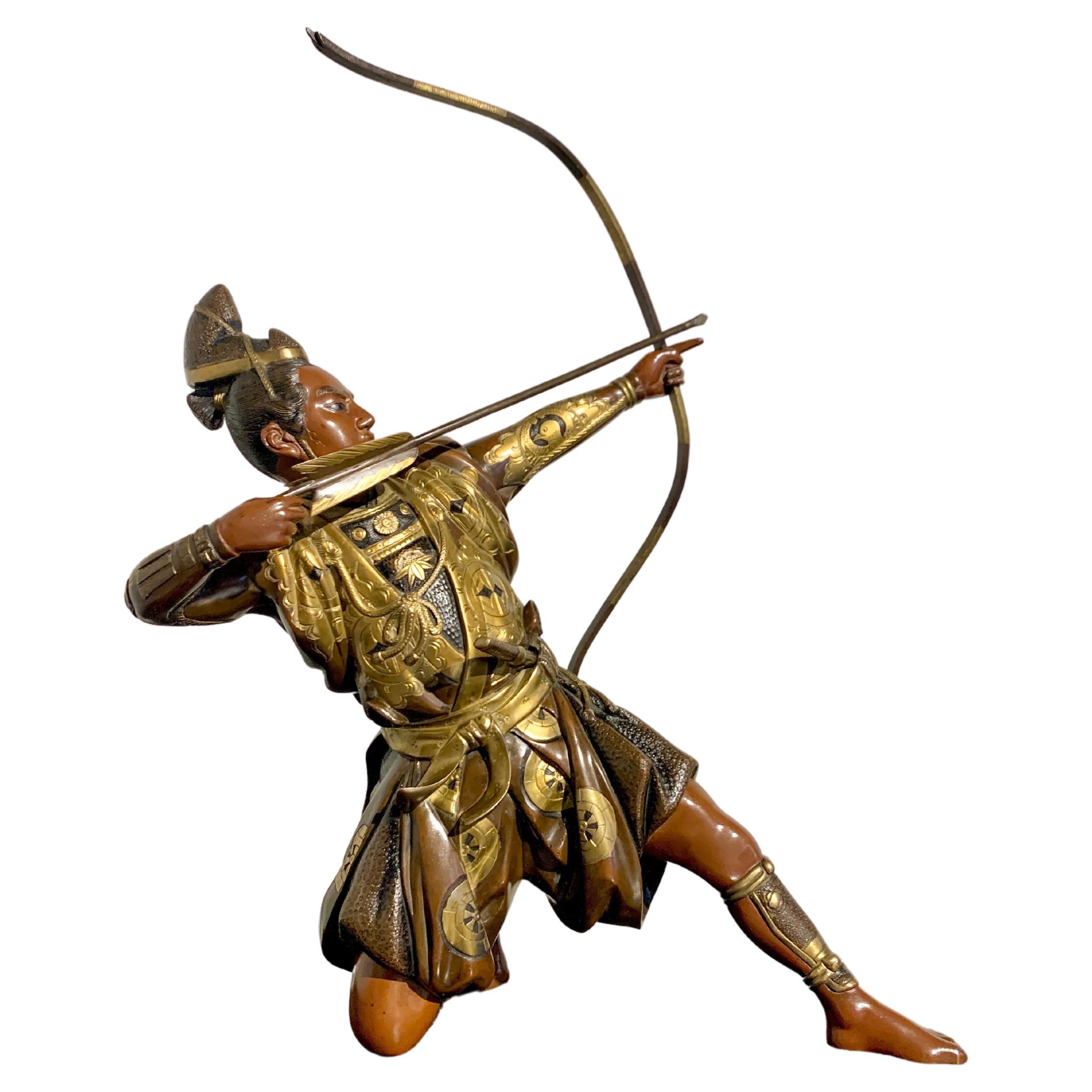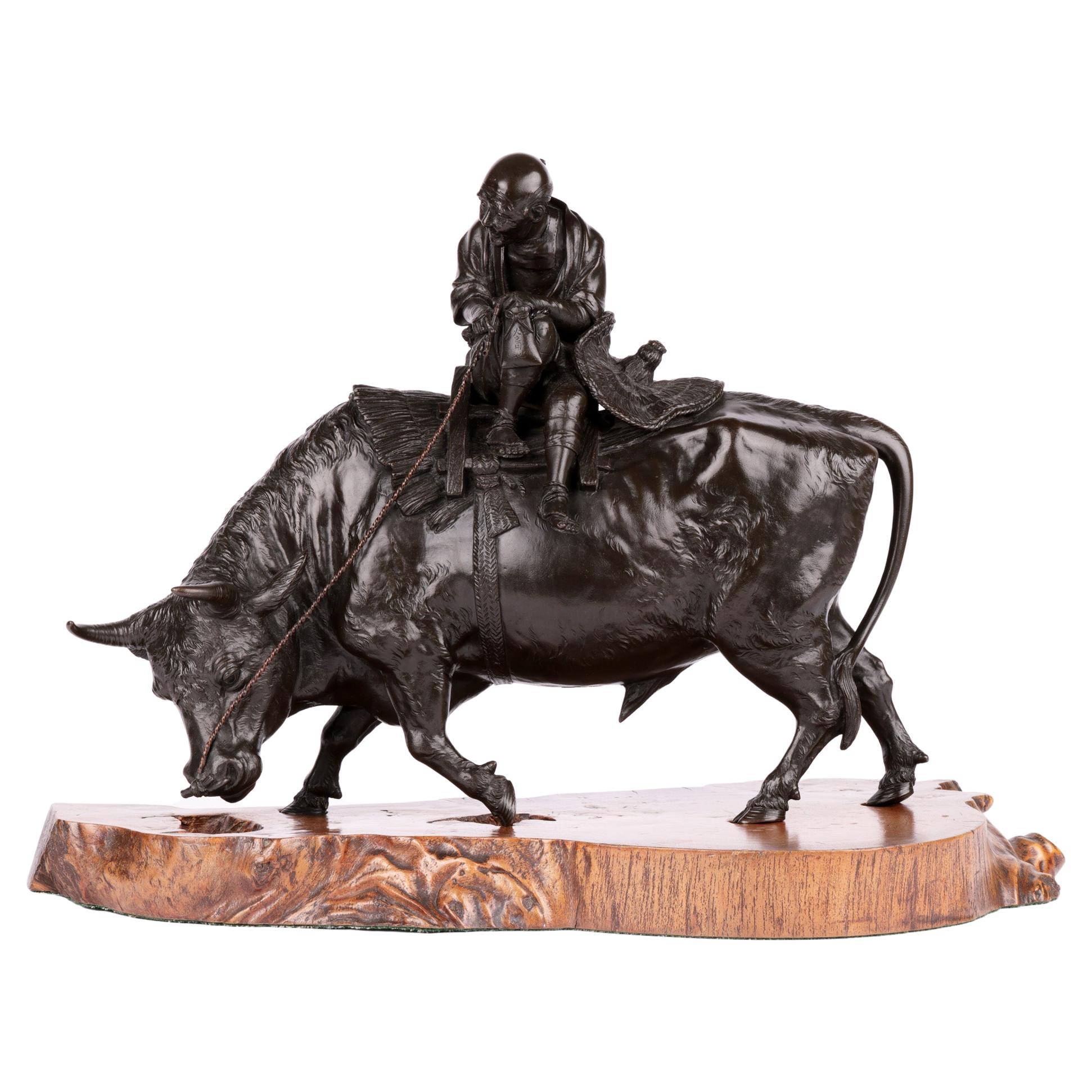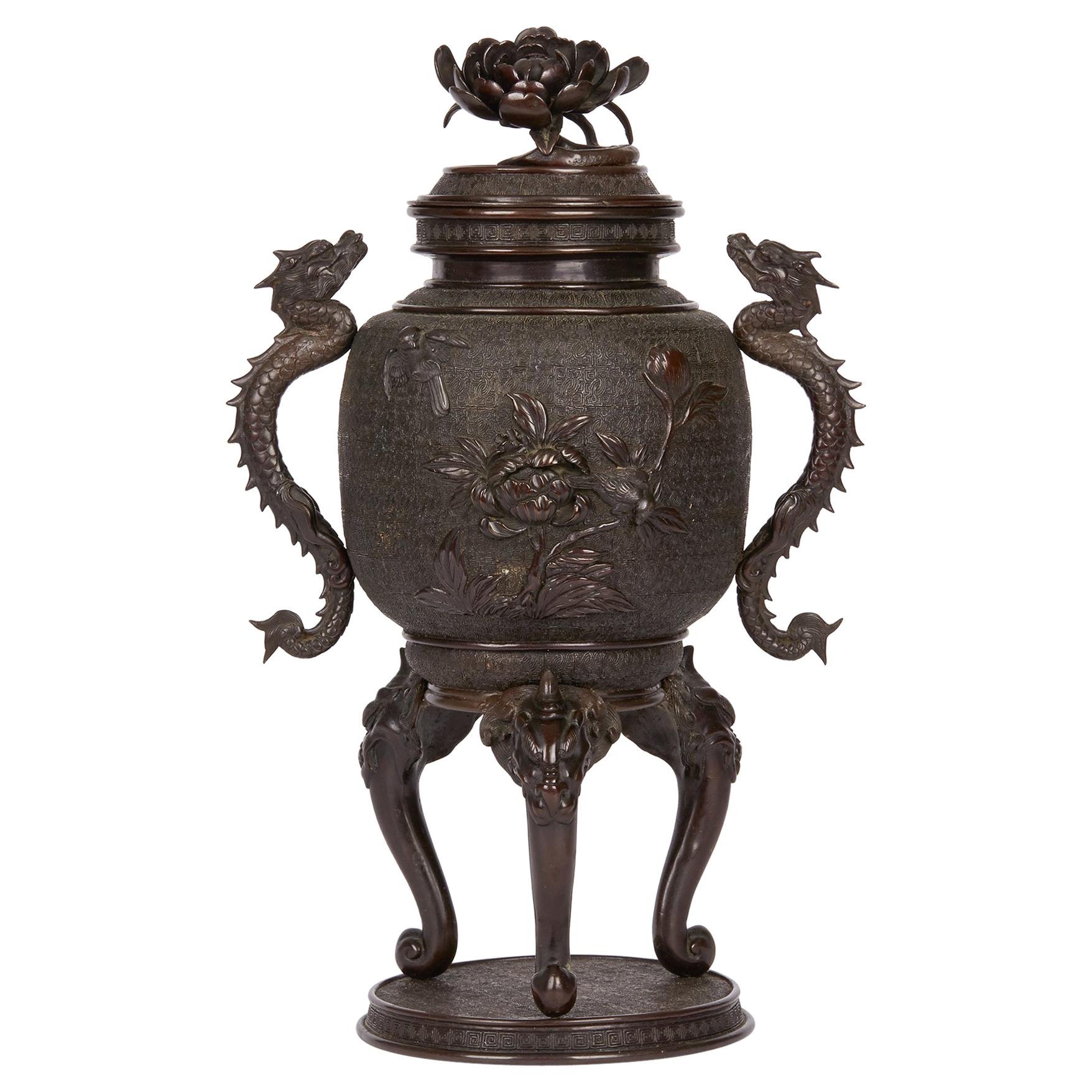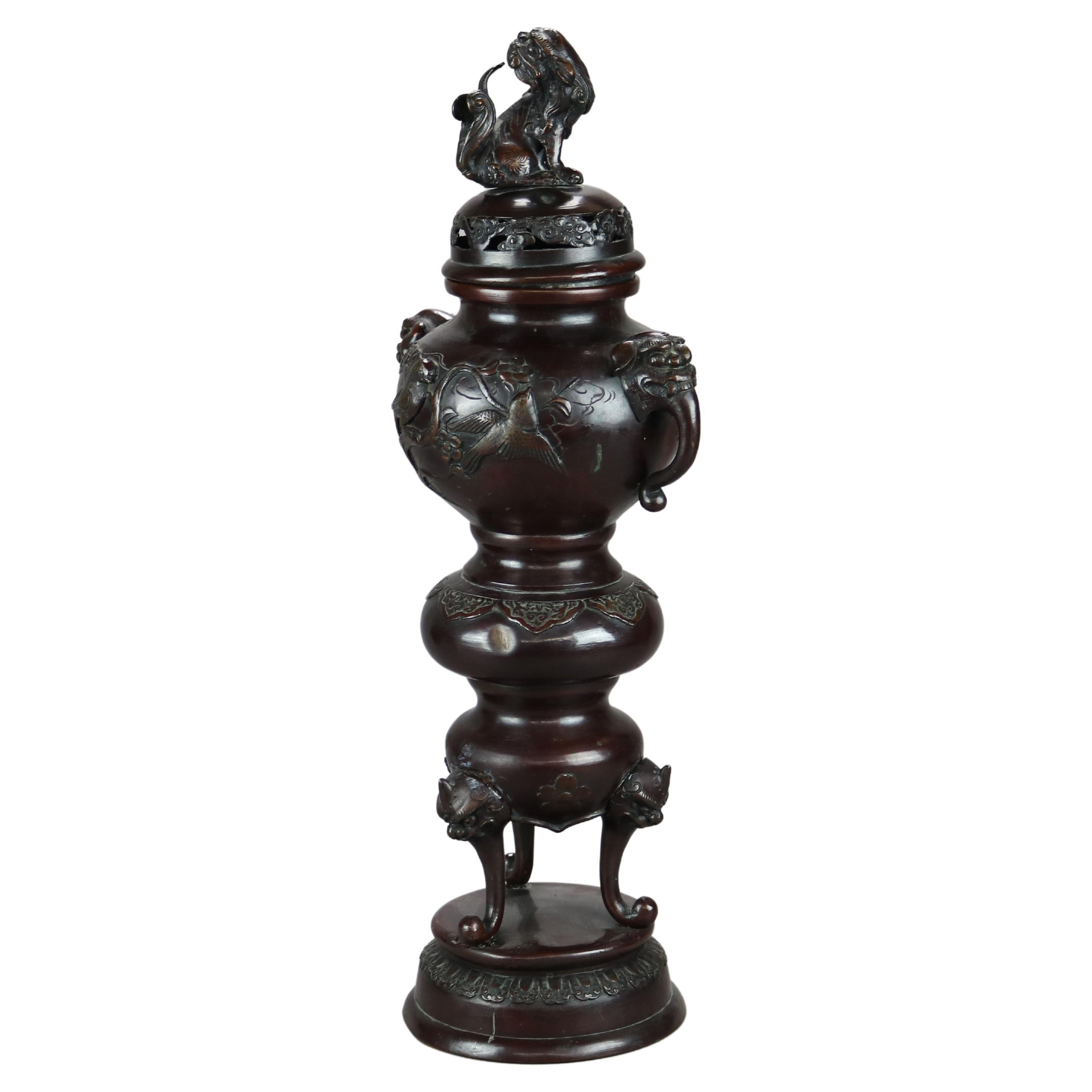Items Similar to Japan Meiji 1900 Three Bronze Ducks Sculpture in Wood Stand and Coral
Want more images or videos?
Request additional images or videos from the seller
1 of 8
Japan Meiji 1900 Three Bronze Ducks Sculpture in Wood Stand and Coral
About the Item
Sculptural composition of the ducks from the Japanese Meiji Period.
Beautiful and very well realized sculptural composition of three ducks, made during the japanese imperial period of the Meiji, back in the 1900. This piece is composed by three standing bronze ducks hanging together on a carved piece of rosewood and embellished with two carvings of natural salmon coral.
Oshidori a Mandarin duck, is an auspicious symbol of eternal love. From ancient times, beautiful artistic patterns on kimono have reflected the Japanese people’s delicate senses towards the changing seasons and how social conventions in the country have changed through its history. The Chinese believe that mandarin ducks mate for life, a belief that spread to the Japanese, Koreans and Vietnamese, all of whom use the pair of birds to symbolise the love of devoted couples. Before mandarin ducks were symbols of romantic love, however, they were invoked as representations of fraternal love.
Weight: 335.9 Grams, (215.32 Dwt).
Measurements: 200 mm by 95.25 mm by 80 mm (7.9 x 3.75 x 3.15 Inches).
Hallmarks: Each duck is stamped in the undersight with Japanese characters.
Meiji period, is an era of Japanese history that extended from October 23, 1868 to July 30, 1912.The Meiji era was the first half of the Empire of Japan, when the Japanese people moved from being an isolated feudal society at risk of colonization by Western powers to the new paradigm of a modern, industrialized nation state and emergent great power, influenced by Western scientific, technological, philosophical, political, legal, and aesthetic ideas. As a result of such wholesale adoption of radically different ideas, the changes to Japan were profound, and affected its social structure, internal politics, economy, military, and foreign relations. The period corresponded to the reign of Emperor Meiji. It was preceded by the Keio era and was succeeded by the Taisho era, upon the accession of Emperor Taisho.
Condition: The overall condition of this piece is excellent. Beside the little normal wear, there is no damage to the wood or the bronzes. This piece has been carefully inspected to guarantee the condition and authenticity.
INVENTORY REF: D010923MEMH/2122.
- Dimensions:Height: 3.15 in (8.01 cm)Width: 7.9 in (20.07 cm)Depth: 3.75 in (9.53 cm)
- Sold As:Set of 4
- Style:Meiji (Of the Period)
- Materials and Techniques:
- Place of Origin:
- Period:1900-1909
- Date of Manufacture:1900
- Condition:Wear consistent with age and use. The overall condition of this piece is excellent. Beside the little normal wear, there is no damage to the wood or the bronzes. This piece has been carefully inspected to guarantee the condition and authenticity.
- Seller Location:Miami, FL
- Reference Number:
About the Seller
5.0
Platinum Seller
These expertly vetted sellers are 1stDibs' most experienced sellers and are rated highest by our customers.
1stDibs seller since 2023
63 sales on 1stDibs
Typical response time: <1 hour
- ShippingRetrieving quote...Ships From: Miami, FL
- Return PolicyA return for this item may be initiated within 1 day of delivery.
More From This SellerView All
- Japan 1900 Meiji Period Charger With A Dragon In Cloisonné Multicolor EnamelLocated in Miami, FLLarge charger in cloisonné from imperial Japan. Beautiful piece of Japanese decorative arts, created during the Meiji imperial period, circa ...Category
Antique Early 1900s Japanese Meiji Metalwork
MaterialsBronze, Copper, Enamel
- Japan 1890 Meiji Period Ebisu Sculpture in Wood Carving of an Old FishermanLocated in Miami, FLAn extremely well detailed wood carving of Ebisu, as a fisherman. Beautiful and well detailed sculpture, created in Japan during the Meiji dynastic period (1868-1912) back in the 1890's. This piece represent the god of good fortune Ebisu. Was exceptionally carved and executed from one solid single piece of rose wood, showing a gorgeous face expression, with intricate details in the hands and feets, he's carrying as usual a rod and a fish. Ebisu (yebisu), ???, god of fortune, the ocean and fisherman. In the japanese mythology is one of the seven gods of luck, sichi-fuku-jin, the patron of the fisherman and tradesmen. he is depicted as a bearded, smiling fisherman with formal long court ropes, often carrying a rod in one hand and a tai, symbolic fish of the good luck, in the other. The height is 14.25 inches (36.20 cm) and the base measurements is 6.5 by 6.45 inches (16.5 x 16.38 cm). Meiji period, is an era of Japanese history that extended from October 23, 1868 to July 30, 1912.The Meiji era was the first half of the Empire of Japan, when the Japanese people moved from being an isolated feudal society at risk of colonization by Western powers to the new paradigm of a modern, industrialized nation state and emergent great power, influenced by Western scientific, technological, philosophical, political, legal, and aesthetic ideas. As a result of such wholesale adoption of radically different ideas, the changes to Japan were profound, and affected its social structure, internal politics, economy, military, and foreign...Category
Antique 1890s Japanese Meiji Sculptures and Carvings
MaterialsWood
- Japan 1890 Meiji Period Decorative Vase In Cloisonné Enamel With Wood BaseLocated in Miami, FLJapanese vase from the Meiji Period (1868-1912). Beautiful antique decorative vase, created in Japan during the Meiji period (1868-1912), circa 1890s. It was carefully crafted in so...Category
Antique 1890s Japanese Meiji Metalwork
MaterialsBronze, Enamel
- Japan 1890 Meiji Period Bronze Koro Censer in Cloisonne Enamel with Jade LidLocated in Miami, FLJapanese Koro from the Meiji Period (1868-1912). Beautiful antique ten sides fluted koro censer, created in Japan during the Meiji period (1868-1912), ci...Category
Antique 1890s Japanese Meiji Metalwork
MaterialsJade, Gold, Silver, Bronze, Enamel
- Japan 1890 Meiji Period Signed Okimono Sculpture of a Group of Skeletons SmokingLocated in Miami, FLSculptural signed Okimono from the Japanese Meiji period (1868-1912). Very rare, unusual and large sculptural assembling of a dysplaying piece of okimono. Created in Japan during the imperial period of the Meiji (1868-1912). This extraordinary okimono was carefully carved depicting a group of three intricately and realistically rendered carousing skeletons (Gaikotsu) in relax and resting position, drinking and smoking. Two of them, probably males representations are resting on a wicker sofa. The third, is a woman seated in a lower stool offering drinking cups of sake on a round tray. A small rectangular bench is arranged in the scene. The composition is displayed on a four-legged carved wood platform with an inlaid red plaque engraved with the artist's signature. The level of detail and the quality of the carving is truly exceptional. Has an exact measurements of 209.55 mm by 196.85 mm by 127.76 mm (8.25 x 7.75 x 5.03 Inches). After an extensive collection of data, comparables and references to this piece, we have only been able to find only three okimono sculptures like this with similar themes and the same quality of work. References Note: A similar carving of four skeletons playing an animated game of dominos, signed Shutaro in an inlaid rectangular red plaque, was sold in London by Christie’s South Kensington in October 14 2014, Lot 120 Sale 5546. References Note: A similar carving with four skeletons in an otherwise typical victorian scene of a photographer and three sitters signed Shutaro in an inlaid rectangular red plaque, was sold in Edinburgh at Lyon & Turnbull in November 7, 2018. References Note: A similar carving with five skeletons seated, playing cards and drinking, was sold in London by John Nicholson Fine Art on September 26, 2018. Meiji period, is an era of Japanese history that extended from October 23, 1868 to July 30, 1912. The Meiji era was the first half of the Empire of Japan, when the Japanese people moved from being an isolated feudal society at risk of colonization by Western powers to the new paradigm of a modern, industrialized nation state and emergent great power, influenced by Western scientific, technological, philosophical, political, legal, and aesthetic ideas. As a result of such wholesale adoption of radically different ideas, the changes to Japan were profound, and affected its social structure, internal politics, economy, military, and foreign relations. The period corresponded to the reign of Emperor Meiji. It was preceded by the Keio era and was succeeded by the Taisho era, upon the accession of Emperor Taisho. Okimono, is a Japanese term meaning for display an ornament; art object; or decorative object, usually displayed in a tokonoma or butsudan "Buddhist altar". It is an ornament or figure, especially one placed in a guest room. An okimono may be a small Japanese...Category
Antique 1890s Japanese Meiji Sculptures and Carvings
MaterialsWood
- Japan 1890 Meiji Period Rare Carved Okimono Of A Father And Son Playing SignedLocated in Miami, FLJapanese Okimono sculpture of a father and son. Very rare and highly detailed sculpture, created during the meiji period (1868-1912) in the imperial Japan, circa 1890. This sculptural Okimono is very well realized and exceptionally proportionate. Show the figures of a father and a son playing, with happiness and smiling. The father hold a big basket at his back and both personages are wearing kimonos richly engraved. This piece was made from a carving with exceptional craftsmanship and intricate details. This sculpture stand itself on his own base and have all retain of the applied ochre ink accents. Measures: 130 mm by 45 mm by 53.3 mm (5.1 x 1.75 x 2.1 inches). Weight: 81.30 grams. Note: This kind of family scene is very rare to seen in nineteenth century japanese iconography. Okimono Is a Japanese term meaning for display an ornament; art object; or decorative object, usually displayed in a tokonoma or butsudan "Buddhist altar". It is an ornament or figure, especially one placed in a guest room. An okimono may be a small Japanese carving, similar to but larger than a netsuke. Unlike the netsuke, which had a specific purpose, the okimono is exclusively decorative and was displayed in the tokonoma. During the Meiji period, many okimonos were made for export to the West. Meiji Period This is an era of Japanese history that extended from October 23, 1868 to July 30, 1912.The Meiji era was the first half of the Empire of Japan, when the Japanese people moved from being an isolated feudal society at risk of colonization by Western powers to the new paradigm of a modern, industrialized nation state and emergent great power, influenced by Western scientific, technological, philosophical, political, legal, and aesthetic ideas. As a result of such wholesale adoption of radically different ideas, the changes to Japan were profound, and affected its social structure, internal politics, economy, military, and foreign relations...Category
Antique 1890s Japanese Meiji Sculptures and Carvings
MaterialsWood, Paint
You May Also Like
- Japanese Miyao Style Gilt Bronze Samurai Archer, Meiji Period, JapanBy Eisuke Miyao 1Located in Austin, TXA spectacular Japanese cast, carved, and parcel gilt bronze sculpture, okimono, of a kneeling samurai archer, signed Kiyotsugu (died 1894), Meiji ...Category
Antique Late 19th Century Japanese Meiji Sculptures and Carvings
MaterialsBronze
- Genryusai Seiya Japanese Meiji Man & Water Buffalo Sculpture on StandLocated in Bishop's Stortford, HertfordshireAn exceptional Japanese Meiji bronze sculpture of a man and water buffalo on a natural polished oak stand by renowned Japanese master craftsman Genryusai Seiya and dating from around 1880/90. The large bronze depicts an elderly man holding a pipe and tobacco pouch...Category
Antique 1880s Japanese Anglo-Japanese Sculptures and Carvings
MaterialsBronze
- Large Japanese Meiji Bronze Lidded Urn, 19th CenturyLocated in Bishop's Stortford, HertfordshireA large and stylish antique Japanese Meiji bronze lidded twin handle urn standing on a rounded plinth base with tongue and grotesque head formed legs with dragon handles and a flat c...Category
Early 20th Century Japanese Meiji Metalwork
MaterialsBronze
- Antique Japanese Bronze Meiji Footed Censer with Figural Foo Dogs & Birds, 1900Located in Big Flats, NYAn antique Japanese Meiji censer offers cast bronze construction with foo dog lid over bulbous vessel having band with birds and flanking handles with foo ...Category
Early 20th Century Japanese Metalwork
MaterialsBronze
- 19th Century Japanese Cockerel and ChickenLocated in London, GBA fine quality set of two Meiji period Japanese cockerel and chicken.Category
Antique Late 19th Century Japanese Meiji Metalwork
MaterialsBronze
- Japanese Bronze Gold Splash Censer, Circa 1900 Meiji PeriodLocated in London, GBA Japanese bronze gold splash censer with lattice form lid. Meiji period. Intricate fine detail.Category
20th Century Japanese Meiji Metalwork
MaterialsBronze
Recently Viewed
View AllMore Ways To Browse
Wood Stand
Love And Wood
Antique Wood Stand
Antique Wood Stands
Sculpture In Stand
Stand For Sculpture
Antique Sculpture Stand
Japanese Modern Wood Furniture
Couple In Woods
Wood Sculpture On Stand
Wood Stand For Sculpture
Antique Wood Stamp
Stand Carved With Sculpture
Modern Wood Carving
Carved Wood Stand Sculpture
Coral Pattern
Coral Japan
Japanese Coral





